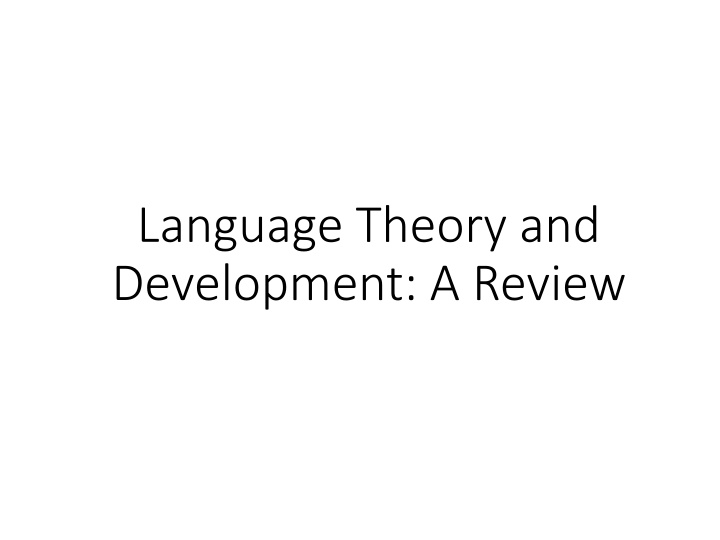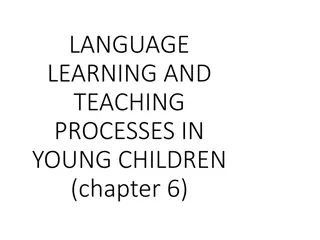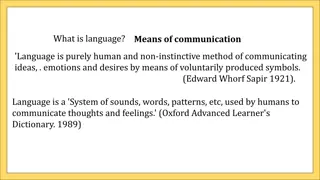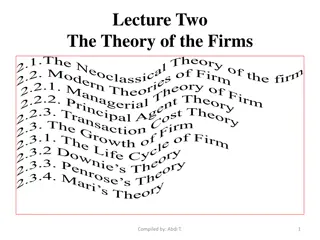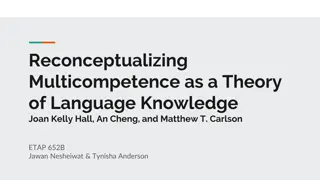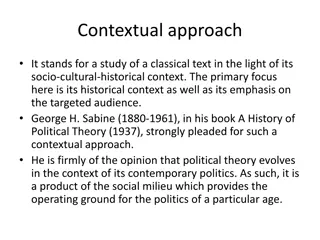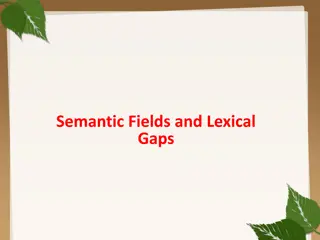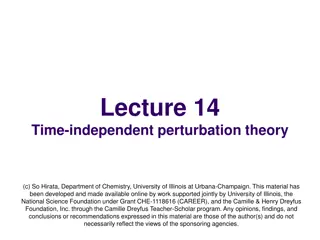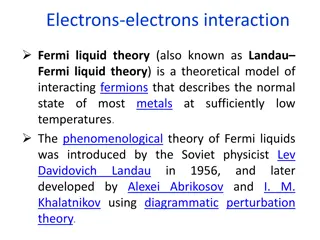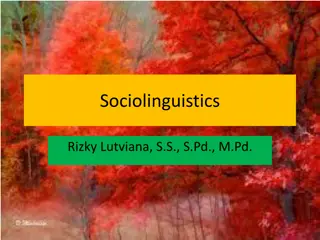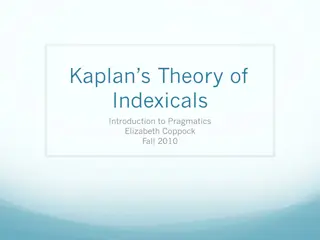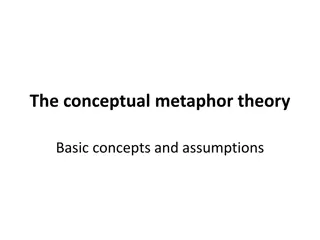New Developments in Language Theory and Development
Explore the latest resources and research in the field of language theory and development. Discover essential texts by authors such as Fogle and Roseberry-McKibbin, covering topics like communication disorders and multicultural language needs. Gain insights into cognitive theory, social interactionism, developmental milestones, and the relationship between various language impairments. Stay updated on terminology and recent studies on language disorders. Dive into early identification methods for communication disorders with Spicer-Cain et al.'s innovative assessments.
Download Presentation

Please find below an Image/Link to download the presentation.
The content on the website is provided AS IS for your information and personal use only. It may not be sold, licensed, or shared on other websites without obtaining consent from the author.If you encounter any issues during the download, it is possible that the publisher has removed the file from their server.
You are allowed to download the files provided on this website for personal or commercial use, subject to the condition that they are used lawfully. All files are the property of their respective owners.
The content on the website is provided AS IS for your information and personal use only. It may not be sold, licensed, or shared on other websites without obtaining consent from the author.
E N D
Presentation Transcript
Language Theory and Development: A Review
Several new resources:** Fogle, P.T. (2023). Essentials of communication sciences and disorders (3rd ed.). Burlington, MA: Jones & Bartlett Learning.
Roseberry-McKibbin, C. (2022). ** Multicultural students with special language needs: Practical strategies for assessment and intervention (6thed.). Oceanside, CA: Academic Communication Associates. Roseberry-McKibbin, C., Hegde, M.N., & Tellis, G. (2024). Advanced review of speech-language pathology: Study guide for PRAXIS and comprehensive examination (6th ed.). Austin, TX: Pro-Ed. www.proed.inc
Hwa-Froelich, D.A. (2023). Social communication development and disorders (2nded.). Routledge. Levey, S. (2024). Introduction to language development (3rded.). Plural Publishing.
I went to a fabulous conference in Richmond, Virginia:** Kathryn Phillips (special ed and psychology background) Effective Strategies for Managing Challenging Behaviors and Teaching Executive Functioning Skills: ASD, ADHD, Anxiety, Sensory Processing
PowerPoint Outline I. Review of Theories A. Cognitive Theory (Piaget) B. Social Interactionism (Vygotsky) II. Review of Relationship of SSD to SLI III. Review of Typical Developmental Milestones A. Infant B. Toddler C. Preschool
Before we dive inthis slide is not on the exam What s the very latest terminology?** Language Impairment Specific Language Impairment Language Disorder Primary Language Impairment Developmental Language Disorder** (in 2020, 2021, 2022, 2023, 2024 journals)
Spicer-Cain et al. (2023). Early identification of children at risk of communication disorders: Introducing a novel battery of dynamic assessment for infants. American Journal of Speech-Language Pathology, 32, 523-544.
Montgomery, J.W., & Gillam, R.B. (2024). Introduction to the Forum: Intervention with children with DLD. AJSLP, 33, 527-529.** They remind us that DLD is a neurodevelopmental disorder where language abilities fall significantly below age expectations in the absence of any known causes such as hearing loss, intellectual disability etc.
Always remember the Big 5 in language:** Syntax Morphology Phonology Semantics Pragmatics
A. Cognitive Theory** Jean Piaget Emphasizes cognition, or knowledge and mental processes Language acquisition is made possible by cognition and general intellectual processes Two forms: strong cognition hypothesis and weak cognition hypothesis
Strong cognition hypothesis:** Cognitive abilities are prerequisites to lang skills language Language will absolutely not develop without these cognitive abilities Cognition
When working with a 10-month old infant on developing object permanence, the SLP can most appropriately have the infant: A. Play pat-a-cake B. Visually follow a moving toy across the floor C. Play peek-a-boo D. Visually locate a musical toy by using its sound E. Play with a pull toy
https://www.youtube.com/watch?v=L4 LMPhUoQeQ Object permanence 2 Leona Youtube video
Preoperational (2 Preoperational (2- -7 years)** 7 years)** Concreteness of thought Ch egocentric; difficulty taking others perspective Overextensions and underextensions occur
Clinical implications of the cognitive theory:** If cognitive development is sufficient for language development, language therapy is unnecessary language Cognitive growth will automatically facilitate language growth cognition
** Clinicians must assess and treat cognitive precursors to language and facilitate development of these precursors before working on language itself So, with a very young child, you would work on symbolic play and object permanence before you tried to have a child say her first word
With your straw Write down 3 things you could do with a young child who does not have symbolic play yet For example, the straw could be used as a microphone What are 3 other things the straw could be used for?
Lev VygotskyRussian psychologist:** Language knowledge is acquired through social interaction with more competent and experienced members of the child s culture
This slide not on exam:** This was a huge problem with Covid It severely limited the # of people children could interact with The number of children with speech and language delays has more than doubled worldwide
Stahnke, L. (2024). Elusive words: Confronting the post-pandemic skills gap. The ASHA Leader, May/June 2024.
This is why I believe.** That multiage child care is so important Mark s language development skyrocketed when, at 3, he left a small homecare of children his own age and entered a large preschool that also had an elementary aftercare program
Children benefit greatly from being around older kids! **
According to social interactionism theory:** Children first learn language in interpersonal interactions, then use this language to structure thought Language develops because children are motivated to interact socially with others around them
Turn to each other and write down specific methods and materials you could use to motivate: A very active 4-year old boy with autism A 10-year old girl with DLD A 16-year old with mild intellectual disability
II. Relationship of Developmental Language Disorder to Speech Sound Disorders
Westby (ASHA Schools Conference Phoenix):
Often Speech sound disorder Language Impairment Speech Sound Disorder
Macrae, T., & Tyler, A.A. Speech abilities in preschool children with speech sound disorder with and without co-occurring language impairment. Language, Speech, and Hearing Services in Schools, 45, 302-313.**
Macrae & Tyler:** Compared preschool children with co-occurring SSD and language impairment (LI) to ch with SSD only Looked at numbers and types of errors in both groups
Lets transcribe some distortions and omissions:
